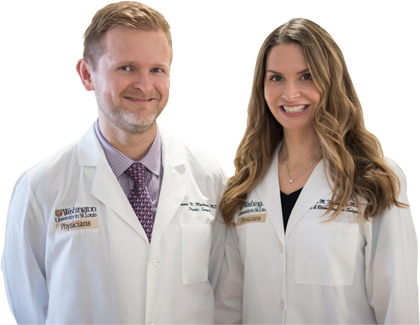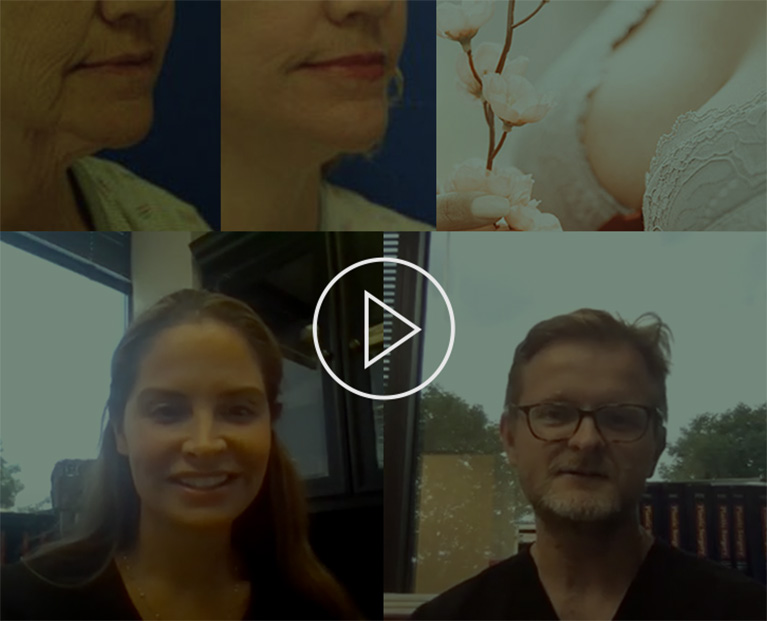Rhinoplasty
Nose Surgery in St. Louis
You may have heard the term before, but you may not know the details of this face procedure: What exactly is a rhinoplasty? The St. Louis-based team at West County Plastic Surgeons procedure uses rhinoplasty to improve the shape of the nose. Patients may perceive that their nose is too large, too small, too short, too long, or crooked. They may be happy with their nose save for one or two subtle features that they would like corrected.
To schedule your consultation for rhinoplasty, contact our St. Louis office by phoning (314) 996-8800 or requesting your consultation online.
What to Expect from Rhinoplasty
The appearance of the nose is influenced by ethnicity, gender, and other pre-existing facial features, such as the position of the chin and upper jaw. Rhinoplasty requires a careful assessment of functional and cosmetic goals, as well as a clear understanding of a patient's expectations and how they relate to what the surgery can reasonably achieve.


Dr. Marissa Tenenbaum and Dr. Terry Myckatyn will assess your nose and how it relates to the rest of your face to determine the best approach to achieving your goals for nose surgery. Occasionally non-surgical rhinoplasty can be done with injectable fillers to camouflage deformities and change the shape of the nose. This can last several years and be done with no anesthesia or downtime.
A rhinoplasty can be performed through an open or closed approach. Each technique has merit and is chosen on the basis of what your surgeon plans to do to try to meet your goals with your rhinoplasty.
The open rhinoplasty approach involves a small incision made on the structure known as the columella, which is the tissue that separates the nostrils. The surgeon can then peel back the skin covering the nose. With the bone, cartilage, and other tissues exposed, visualizing both the problem and the solution is a matter of directly seeing what needs to be corrected. When the work is done, the tissue will be re-draped, and the incision closed. The most modern techniques are used to ensure any scar is as minimally noticeable as possible.
The closed rhinoplasty approach avoids the small incision of the columella, instead consisting of internal incisions that will leave no marks that can be seen. Since no skin is peeled back, there is no direct visualization of the internal structures. Our experienced plastic surgeons are very familiar with the "lay of the land" and can make the necessary adjustments via this technique.
As noted above, each approach has its own merits, which can be discussed at an initial consultation.
With the approach determined, the rhinoplasty surgery itself may involve removing small amounts of tissue, repositioning tissue, or even grafting tissue harvested from other areas of the body. The goal is not to create an entirely "new" nose, but to create a structure that looks like it fits well with the rest of the face.

Dr. Terry Myckatyn and
Dr. Marissa Tenenbaum:
Trusted. Experienced. Committed.
Click here to view a video on rhinoplasty.
Anesthesia: Rhinoplasty is typically performed with the patient under general anesthesia.
Length of procedure: 1 to 5 hours, depending on the extent of the rhinoplasty surgery.
Estimated recovery time: You can return to work after 1 to 2 weeks, depending on the extent of the procedure, but should avoid vigorous activities—especially those that may cause injury to the face—for 3 to 6 weeks. You may be required to wear a splint on the inside or outside of your nose for several days after surgery. Visible bruising should clear up within 2 weeks. Significant swelling may resolve in a couple of weeks, but subtle swelling may be noticeable to you for several months. To learn how to prepare for a rhinoplasty and what to expect afterward, click here to download our patient instructions for rhinoplasty.
Side effects: Nose surgery commonly causes bruising and swelling, as well as results in a well-hidden scar, and possibly well-hidden scars, within the nose, along the inner surface of the ear, or underneath the breast if cartilage was required. Click here to download a detailed consent form from the American Society of Plastic Surgeons that lists the risks and benefits of rhinoplasty surgery.
Before-and-after photos of rhinoplasty results: Click here
Rhinoplasty or Septoplasty?
Cosmetic problems are often accompanied by structural problems within the nose that can impact breathing. Correction of breathing through the nose may require straightening of the partition (or “septum”), which divides the right and left halves of the nose. Straightening this septum is called a septoplasty and may be covered by insurance. Similarly, bony structures within the nose, called turbinates, shrink and swell as they serve to humidify air traveling through the nose. Surgical correction of the turbinates may also accompany a rhinoplasty to improve breathing and may also be covered by insurance.
Procedures That Complement Rhinoplasty
Facial Implants
On occasion, a nose may appear large, but careful evaluation may reveal that the nose itself is normally proportioned while the chin is receded, thus making the nose look bigger. In this case, the chin can be augmented with facial implants for the chin.
Similarly, in other instances, the nose may look small when really it's the chin that is protruding. In this case, the patient may benefit more from a repositioning of the chin or jaw.
Cartilage Grafts
Your own cartilage is usually the best material to augment or support your nose during rhinoplasty surgery. Cartilage is typically harvested from inside the nose from the septum, from the inner ear, or from a rib. Cartilage grafts are more frequently used if the nose needs to be augmented or straightened or when you already have had a rhinoplasty.
BOTOX®
Although the popular filler BOTOX® may be best known for smoothing out forehead lines, as well as frown lines that appear just above the nose, the West County Plastic Surgeons team also uses it to decrease the appearance of what are known as "bunny lines," which crinkle the bridge of the nose. Named because of the way they form as the nose is wrinkled (similar to imitating a bunny's distinctive nose twitch), bunny lines can relax for months at a time with help from up to 10 units of this neuromodulator.
Facial Fillers
While the nose is a focal point for the face, other areas can also feature contours that you may want to address. Dermal fillers, such as Juvederm®, can be used to add volume to the face, creating rounder cheeks where the loss of fat has caused hollows to form. Our talented injectors can use small amounts of filler to make subtle contouring changes that give the entire face a balanced and more youthful appearance.
Blepharoplasty
Slightly higher on the face, genetics and aging tissues can cause upper eyelids to sag, making you appear as if you are constantly mid-wink. In more pronounced cases, the sagging tissue can interfere with a clear field of vision. On the lower eyelids, sagging can create "bags" to either side of the nose. Upper-lid eyelid surgery and lower-eyelid surgery can fix these respective problems.
If you have questions about rhinoplasty in St. Louis or would like to book a consultation with one of the surgeons at West County Plastic Surgery, please call (314) 996-8800.













